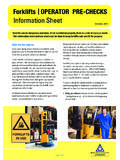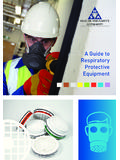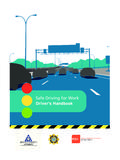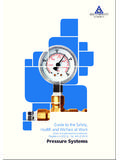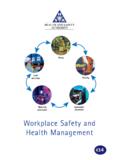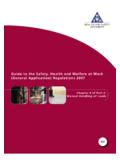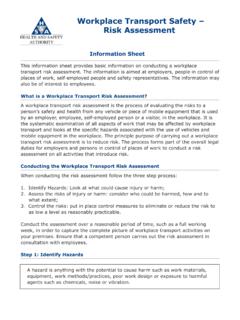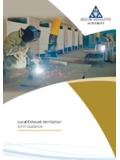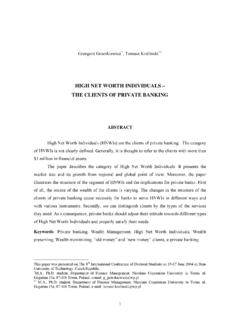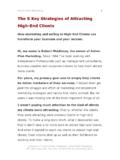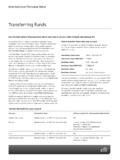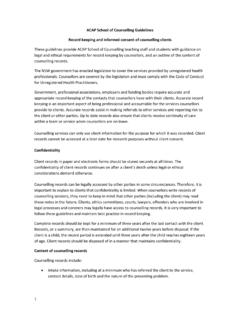Transcription of Clients in Construction - Best Practice Guidance
1 ClientsinConstructionBestPracticeGuidanc ePublished in 2009 by the Health and Safety Authority, Metropolitan Building, James Joyce Street, Dublin 1. Copyright The Health and Safety Authority January 2009 iClients in Construction : best Practice GuidanceHealth and Safety Authority CONTENTSSECTION 1 INTRODUCTION BACKGROUND 1 THE INTENDED PURPOSE OF THIS Guidance 1 SECTION 2 Clients WHO IS A CLIENT? 3 WHAT IS A CLIENT S LEVEL OF SAFETY EXPERTISE? 4 WHY IS IT IMPORTANT FOR A CLIENT TO BE INVOLVED IN HEALTH & SAFETY? 5 BENEFITS AND CONSEQUENCES 5 Clients AND THE LAW 6 THE Construction SAFETY MANAGEMENT TEAM 8 RISK ASSESSMENT 12 WHAT DOES THE CLIENT NEED TO DO? 14 SUMMARY OF ASSESSMENT 15 SUMMARY OF APPOINTMENTS 16 Clients PROVIDING INFORMATION 16 WORKING WITH THE DESIGNER, CONTRACTOR AND PROJECT SUPERVISORS 18 NOTIFICATION OF Construction PROJECTS FOR Clients 19 ACCIDENTS AND INCIDENTS 20 LACK OF PERFORMANCE FROM THE PSDP, DESIGNER, PSCS OR CONTRACTOR 20iiClients in Construction : best Practice GuidanceHealth and Safety AuthoritySECTION 3 DESIGNERS AND CONTRACTORS DESIGNERS 22 WHO IS THE DESIGNER?
2 22 DESIGNER ASSESSMENT AND APPOINTMENT 22 DUTIES OF THE DESIGNER 23 CONTRACTORS 24 WHO IS A CONTRACTOR? 24 CONTRACTOR ASSESSMENT AND APPOINTMENT 24 WHAT CAN YOU EXPECT FROM THE CONTRACTOR? 25 DUTIES OF THE CONTRACTOR 25 SECTION 4 PROJECT SUPERVISORS PROJECT SUPERVISOR DESIGN PROCESS 27 WHO IS THE PROJECT SUPERVISOR DESIGN PROCESS? 27 ASSESSMENT OF PROJECT SUPERVISOR DESIGN PROCESS (PSDP) 27 WHAT RESOURCES SHOULD THE PSDP DEDICATE TO THE ROLE? 27 WHEN SHOULD PSDP BE APPOINTED? 28 WHAT CAN YOU EXPECT FROM THE PSDP? 28 DUTIES OF THE PROJECT SUPERVISOR DESIGN PROCESS 29 PROJECT SUPERVISOR Construction STAGE 30 WHO IS THE PROJECT SUPERVISOR FOR Construction STAGE 30 ASSESSMENT OF PROJECT SUPERVISOR Construction STAGE (PSCS) 30 WHAT RESOURCES SHOULD THE PSCS DEDICATE TO THE ROLE?
3 31 WHEN SHOULD THE PSCS BE APPOINTED? 31 WHAT TO EXPECT FROM THE PSCS 31 DUTIES OF THE PROJECT SUPERVISOR Construction STAGE 32iiiClients in Construction : best Practice GuidanceHealth and Safety AuthoritySECTION 5 CHECKLISTS CLIENT CHECKLIST AND COMPETENCY QUESTIONNAIRES 34 SECTION 6 NOTIFICATIONS HSA APPROVED FORM AF1 39 SECTION 7 COMMON ISSUES FOR Clients WHEN DO THE Construction REGULATIONS APPLY? 42 MORE THAN ONE CLIENT 42 CLIENT ASSESSMENT AND APPOINTMENT SCENARIOS 43 CLIENT APPOINTING THEMSELVES AS PROJECT SUPERVISOR 43 USE OF APPROVED SUPPLIERS 44 PARTNERSHIP AGREEMENTS 44 MULTI-SITE AND MULTI-CONTRACTOR PROJECTS 45 SECTION 8 CLIENT S POSITIVE INFLUENCE ON SAFETY INFLUENCING SAFETY THE CLIENT 47 MONITORING OF HEALTH AND SAFETY DURING THE PROJECT 47 SAFETY AWARD SCHEMES 48 CONTRACTOR BASED SAFETY AWARDS 48 INDIVIDUAL SAFETY AWARD SCHEMES 48 SECTION 9 FURTHER INFORMATION PUBLIC SAFETY 50 WHAT OTHER CONCERNS SHOULD THE CLIENT TAKE ACCOUNT OF?
4 50 LEGAL REQUIREMENTS FOR PUBLIC SAFETY 51 SAFETY FILE 51 THE SAFETY FILE WHAT IS IT? 51ivClients in Construction : best Practice GuidanceHealth and Safety Authority CONTENTS OF THE SAFETY FILE 51 SECTION 10 GLOSSARY DEFINITIONS 53 KEY PEOPLE 53 KEY TERMS 53 PARTICULAR RISKS 55 SCHEDULE 1, SAFETY, HEALTH AND WELFARE AT WORK Construction REGULATIONS 2006 551 Clients in Construction : best Practice GuidanceHealth and Safety AuthorityS. BACKGROUNDThe majority of Clients are fi rst time, one-off Clients , who are acting in the role for the fi rst and possibly the only time. The role of the client may be fi lled by a wide variety of people ranging from farmers, doctors or publicans to Local Authorities and large multinational guidelines are designed to clarify the requirements of the legislation, for the smaller one-off Client, as well as the larger and more experienced Client.
5 The guidelines introduce the duties regarding various parties involved in a Construction THE INTENDED PURPOSE OF THIS GUIDANCEThis Guidance , (which is issued by the Health and Safety Authority), aims to clarify the role of the Client. It is not compulsory and you are free to take other actions to achieve compliance. If you do follow this Guidance you will normally be doing enough to meet the requirements of the law. The aim of this document is to give advice and assistance to everyone who may have to fulfi l the role of Client under Section 17 of the Safety, Health and Welfare at Work Act 2005 and the Safety, Health and Welfare at Work ( Construction ) Regulations 2006. This document is designed to allow the smaller scale once-off Client identify their own duties and the duties of the persons they have appointed. Larger Clients may be interested in a more in depth review of aspects of the legislation as well as the strategies that have been adopted to enhance the level of safety management by other Clients .
6 The law applies equally to all Clients . This does not mean that a small fi rst time Client will have to devote the same amount of resources as a large multinational company. It is important that the resources employed are proportionate to the scale of the project and the risks related to that project. SECTION 1 INTRODUCTION2 Clients in Construction : best Practice GuidanceHealth and Safety AuthorityS. 1 Guidance is provided in ten sections: Section 1 : (this section) introduces the document;Section 2 : outlines the different types of Client that can exist and how the legislation applies; Section 3 : briefl y outlines the duties of Designers and Contractors; Section 4 : briefl y outlines the duties of the Poject Supervisor Design Process (PSDP) and the Project Supervisor Construction Stage (PSCS); Section 5 : provides checklists and competency questionnaires that Clients can use when appointing Designers, PSDP, Contractors and PSCS; Section 6 : includes the Health and Safety Authority s approved form for notifi cation of the appointment of project supervisors (AF1 form); Section 7 : considers some common issues for Clients ; Section 8 : outlines how Clients can exert a positive infl uence on health and safety for their projects.
7 Section 9 : provides some further information, which may be of assistance to fi rst time Clients ; Section 10 : provides defi nitions of some common terms. 3 Clients in Construction : best Practice GuidanceHealth and Safety AuthorityS. WHO IS A CLIENT?DEFINITION OF A CLIENTA Client means a person for whom a project is carried out, in the course or furtherance of a trade, business or undertaking, or who undertakes a project directly in the course or furtherance of such trade, business or Client is the person or company, with the controlling interest in the project. Generally the Client will retain a signifi cant level of control over the assessment and appointment of Designers and Contractors for a , there are many types of Clients who will fi nd this Guidance benefi cial:Doctors, extending their Surgery; Hoteliers or B&B proprietors, extending their premises; Publicans, extending their premises; Farmers constructing outbuildings; A supermarket or shopkeeper, refurbishing their premises; A small manufacturer, installing new machinery; A Local Authority or a Hospital Authority engaged in Construction activities; A School board, building an extension or renovating.
8 This document seeks to explain the following:What is a Client s role? What is a Client s level of expertise? Why is it important for the client to be involved in health and safety? What are the Benefi ts and Consequences? What are the legal requirements that a Client must fulfi l? What are the Construction Regulations ? What is a risk assessment? What are the assessment and appointments requirements? What should a Client expect from the other parties involved in a Construction project?How does a Client notify a project? SECTION 2 CLIENTS4 Clients in Construction : best Practice GuidanceHealth and Safety AuthorityS. 2A domestic homeowner or Client who manages Construction work for a fi xed sum or supplies materials, labour or both for a Construction project, is defi ned as a Contractor. For example, where a homeowner undertakes the Construction of a domestic house by labour only, they will be required to comply with the duties of a Contractor which are outlined in Section Homeowners who follow this Guidance will help to ensure that their Designers and Contractors comply with their duties under the Act and Regulations.
9 WHAT IS A CLIENT S LEVEL OF SAFETY EXPERTISE?It is recognised that not all Clients would possess the knowledge and expertise to take a leading role in Construction safety. A large proportion of Clients are smaller private agencies functioning as a Client for the fi rst time. 5 Clients in Construction : best Practice GuidanceHealth and Safety AuthorityS. 2 This lack of experience does not necessarily mean a loss of commitment to safety performance. A Client s commitment to safety can be demonstrated by the allocation of adequate attention and resources to the appointment of a competent Project Supervisor Design Process, Project Supervisor Construction Stage, a Designer or Contractor. This will allow them to fulfi l their roles and will reinforce this commitment to safety. A Client can and should infl uence the people they have appointed, in order to get value for money and ensure the safety of those engaged in their Client can infl uence the way that safety is applied during design and Construction , by simply showing an interest in safety and safe working practices when visiting the site or meeting with Designers, Contractors or Project Supervisors.
10 By making their interest clear the Client is setting a standard that is conducive to a safe working WHY IS IT IMPORTANT FOR A CLIENT TO BE INVOLVED IN HEALTH & SAFETY?HSA research has shown:45% of sites, where a fatality occurred, the Clients had failed in their duties to appoint a Project Supervisor Design Stage (now Design Process) or a Project Supervisor Construction Stage, for their Construction of Construction accidents were related to omissions or failures to address health and safety issues, prior to the start of the Construction stage. (Design Stage/Process).This is refl ected in changes in the Safety, Health and Welfare at Work ( Construction ) Regulations 2006, which now require Clients , Project Supervisors Design Process (PSDP) and Designers, to have more robust duties assigned to them. This ensures safety is managed from the outset of a Construction BENEFITS AND CONSEQUENCES The involvement of the Client and the correct fulfi lment of the Client s statutory duties can have a direct impact on the safe working practices on Construction projects.
